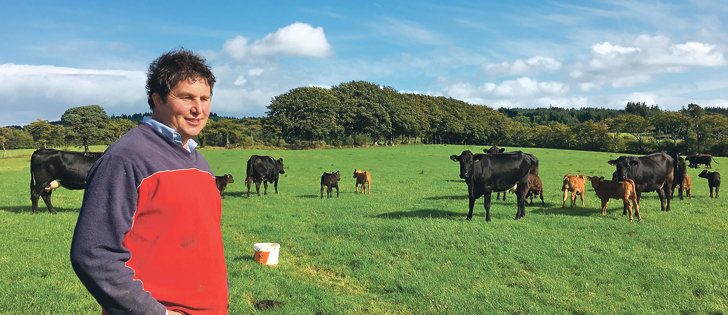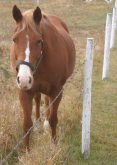Barbara Duckworth is on assignment in England, Scotland and Ireland and will be filing reports on agriculture, Brexit and other topics in coming issues.
NEWTOWNMOUNTKENNEDY, Ireland — Pat Nuttall’s family has been farming the same piece of land in Ireland for 250 years, but he fears he may be the last generation.
He loves the land in Wicklow County, but he is up against the same challenges many other modern farmers face.
Located a half hour from downtown Dublin, a city of more than two million, there are urban-rural pressures, market volatility and a younger generation less interested in farming.
Read Also

Beef check-off collection system aligns across the country
A single and aligned check-off collection system based on where producers live makes the system equal said Chad Ross, Saskatchewan Cattle Association chair.
He and his schoolteacher wife, Fiona, have a four-year-old son who can make his own decisions about the future.
Related Stories:
“Would I encourage him? No. We are the last generation of full- time farmers in this area because there is nothing in it,” he said in an interview at his kitchen table in a home that is more than 200 years old.
“If a farm comes up for sale around here, it will be a rich person that buys it. It won’t be a farmer.”
Inflated land prices following the Irish real estate boom 10 years ago made it impossible for people like Nuttall to expand his 300 acres. The wealthy surround the family farm, and his neighbours include people like actor Daniel Day Lewis, sports stars and a member of the band U2.
However, the relationships are amicable as both sides work on being good neighbours. The illustrious neighbours have lived in the region long enough to understand livestock makes noise, stray dogs may get shot and manure has to be spread.
The family also deals with market unpredictability. Lamb and beef prices are shaky, and the recent volatility of the English pound sterling versus the euro forces creative measures to boost the family’s income.
Nevertheless, Nuttall had no doubt he wanted to farm.
He left the farm at age 11 to attend boarding school for six years. He then went to agriculture college and travelled in Australia before returning to take over the farm in 1995.
The European Union was offering a payout to retiring farmers so his father took the package and Nuttall was able to make a smooth transition within about six months.
“We were the first people in this area to do early retirement,” he said.
He had three good years but in 1998 a single cow reacted to a routine bovine tuberculosis test. His entire cow herd of about 100 was depopulated. He was compensated but TB is a sore point for him.
Decades ago the owner of the nearby Mount Kennedy estate imported a non-native herd of Sika deer for hunting, which eventually started to mix with the native red deer.
While the British Isles conducts an annual badger cull because these are considered a disease reservoir, farmers struggled to convince the department of agriculture that the deer were also carrying TB. Three years ago the government agreed to test more than 100 from the area and about 16 percent were positive for the disease.
“It is a can of worms the department doesn’t know what to do with,” he said.
“They laughed at us for years, but until we had scientific proof they realized we are in trouble.”
There are no natural predators in Ireland, and most of the deer were controlled with hunting.
At one time poverty stricken people started poaching the deer at night to sell the venison.
“You could shoot a deer and get 50 quid for it and get paid a bit of money,” he said.
The government clamped down and created a national park to control poaching and the deer started to roam.
“The deer are out of control,” he said.
“They are in our forage, and we had one last year sleeping in the middle of the lawn during the day.”
As if TB was not enough, in 1999 his flock of Suffolk cross sheep was struck with toxoplasmosis, a contagious disease that causes abortions. About 160 ewes of his flock of around 450 lost their lambs.
He got back on his feet and today he has about 460 ewes and his beef herd is about 120 head with 40 to 50 cows of Limousin-Friesian breeding. The cows are docile and moderate in size and produce plenty of milk.
“Most of the suckler herds in Ireland would be Limo cross Friesians,” he said.
“Some people are going three-quarter bred, but with our system I just feel you can get a half-bred and they are quiet.”
The cows are bred to a Black Angus bull, and calving is scheduled for January and August.
Cattle are housed indoors during the cold, rainy winter months, but he does not have big enough facilities to contain them all in the calving shed, so he splits the herd into two calving groups.
The fall calvers deliver outdoors.
The fall calves are sold at around 24 months of age in December, while the spring crop goes to market at around 20 months of age in April or May.
The males are castrated when calves are a week old, and everything receives two ear tags as part of the national traceability scheme.
Most of his cows are solid black, so he freeze brands the last three or four digits of their unique identification number on the shoulder to help recognize and sort them in the pasture. Branding is not common in Ireland.
The sheep are also housed indoors during winter and live on slatted floors so the manure can drop through to a slurry pit. Lambing is scheduled to start March 20.
Farm help is hard to come by. Fiona has a full-time job but makes herself available to help. They also hire two or three agriculture students during this busy time.
The lambs receive a colour coded management tag based on the year they were born. The breeding stock is identified with an electronic tag at one year of age.
The lambs go to market at 40 to 60 kilograms live weight, and probably 40 percent of the meat goes to France.
All the livestock is finished on grass. Most of the land is seeded to tame grasses and clover. Very little alfalfa is grown in Ireland.
The region might receive a metre of moisture in a normal year, but this year has been dry and he only received 700 millimetres. The grass is growing slowly, and water wells are low.
Manure is used for fertilizer, and Nuttall soil tests every four or five years. The region is low in phosphorus and potassium as well as cobalt, copper and iodine. The cows receive loose mineral supplements to make up for the shortfall.
He has about 35 acres of natural forest, but he has been actively planting trees as part of an environmental project and eventual logging opportunities. In 1995 he put in 28 acres of larch, spruce, oak and beech trees that can also be harvested for timber.
This year he is adding eight more acres of spruce. The forestry initiative was a 20 year tax free income program and Nuttall wanted another revenue stream.
“It was EU money. I am a happy European for stuff like that. It was basically marginal land,” he said.
Nuttall is a supporter of quality assurance programs and is a part of the Irish sustainability program Origin Green.
These are voluntary, but it is almost impossible to market commodities without being on an audited program that oversees animal care, pasture management and environmental stewardship.
Two rivers pass through the farm before flowing into a reservoir to supply Dublin with drinking water.
“We have got to be squeakier than squeaky clean, and it is logical because if we don’t mind our land, we won’t have our land,” he said.
The land is green and scenic under the family’s stewardship. The BBC television network used this farm and the house last year for the production of a six part series called Redwater, a spinoff of the Eastenders soap opera.
More than 60 cast and crew moved onto the property for 20 days in total.
The crew arrived at the end of lambing and the family worried about the intrusion.
“We just lived with them and carried on,” he said.
The crew moved out all their furniture, repainted the interiors, built a new porch and added a grand flower bed, lane and an iron sculpture made from scrap on the farm. The family enjoyed the experience and now see potential to offer the place for future productions.
They hobnobbed with the cast and ate with the crew. Nuttall said he was impressed with the food quantity and quality.
“The only problem was they had fish on the menu every day. I don’t eat fish. It doesn’t have legs.”


















